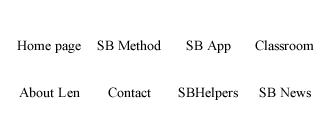Stave Breakthrough™ Method
The Stave Breakthrough™ Method
Please look at the graphic below, if you recognise the note by its position on the stave as a G note with the time value of 2 beats prepare to start using Stave Breakthrough. If you don't, then ask your teacher to explain the fundermentals of the stave.
 |
The G note has a duration of two beats and is referred to as a Minim (UK/Europe) or Half Note (USA). To make it easier Stave Breakthrough prefers each note to be named by its length. That is, the number of beats between each event written on the stave.
Instead calling the note a minim say it's a 2 beat note. It is important to know it is a minim for exams and when talking to other musicians.

In the example below 2 single beats must pass before the next note is sung, played or stops if the next event is a rest. The note to play, or sing, in any clef is a G. Again, for clarity, a 2 beat note means in 2 beats time the next event must take place.
In the example below 2 single beats must pass before the next note is sung, played or stops if the next event is a rest. The note to play, or sing, in any clef is a G

Before reading a piece of music in the Stave Breakthrough manner students should name the Key, the number of beats per measure and take note of the tempo. These parts, the key, the time signature, the tempo and dymanics all have their own section in Stave Breakthrough.
The two parts of the note in this example are 1) a G note and 2) the time value of 2 beats. When reading music the speed at which your brain handles those two pieces of information is critical to the note being played and the next note prepared.
This is the problem. A "G note that lasts for two beats," takes longer to say than it does to play.
Tap a constant rhythm on the table as you say, "a G note that lasts for two beats," you will find it takes 4 beats to say. Two beats too long. If a note is 2 beats long and the thought process 4 beats long it's understandable why students find reading music hard to get to grips with.
The Stave Breakthrough technique condenses this to a “2 beat G.” Instantly solving the problem.
 |
Please read the Handbook carefully and download the app to ensure everything about Stave Breakthrough is understood.
The annotations written on the music below, are a visualisation of what a student "sees" when using Stave Breakthrough™. A pencil can be used to write the annotations on the music, but only as a temporary measure.
Students say the timing and the notes aloud in the SB manner while reading their music.
![]()
 |
When reading notes from the stave using the Stave Breakthrough method in a classroom situation, or a private lesson, a teacher should listen while a student reads aloud from the score. At home students can record their efforts to assist their progress.
No instrument or singing is required
Within a few minutes the rendition will become smoother and the student more assured. When the hesitations and faltering have disappeared completely it is time to play or sing the piece.
Stave Breakthrough™ is completely free to use following contact with Len Collins, providing it is not used as part of any commercial venture and all creditation given to Len Collins and Stave Breakthrough™.
Stave Breakthrough™ works with all traditional sheet music, instruments and voices. Stave Breakthrough can also speed up reading of key signatures and dynamics.
Next - Key Signatures, Dynamics and Time signatures.
